
Flagstaff is a city in, and the county seat of, Coconino County in northern Arizona, in the southwestern United States. In 2019, the city's estimated population was 75,038. Flagstaff's combined metropolitan area has an estimated population of 139,097.
The music of Arizona began with Indigenous music of North America made by Indigenous peoples of Arizona. In the 20th century, Mexican immigrants popularized Banda, corridos, mariachi and conjunto. Other major influences come from styles popular throughout the rest of the United States.

Downtown Phoenix is the central business district (CBD) of the City of Phoenix, Arizona, United States. It is located in the heart of the Phoenix metropolitan area or Valley of the Sun. Phoenix, being the county seat of Maricopa County and the capital of Arizona, serves as the center of politics, justice and government on the local, state and federal levels. The area is a major center of employment for the region, with many financial, legal, and other national and international corporations housed in a variety of skyscrapers. Major arts and cultural institutions also call the area home. Downtown Phoenix is a center of major league sports activities, live concert events, and is an equally prominent center of banking and finance in Arizona. Regional headquarters for several major banks, including JP Morgan Chase, Wells Fargo, US Bank, Bank of America, Compass Bank and Midfirst Bank are all located within or close proximity to the area.
Orpheum is a name often used for theatres or other entertainment venues. It may refer to:

The Orpheum Theatre, a 2,308-seat venue listed on the National Register of Historic Places, is located in downtown Memphis, Tennessee, on the southwest corner of the intersection of South Main and Beale streets. The Orpheum, along with the Halloran Centre for Performing Arts & Education, compose the Orpheum Theatre Group, a community-supported nonprofit corporation that operates and maintains the venues and presents education programs.
KCLS was a radio station broadcasting in Flagstaff, Arizona. Charles J. Saunders put it on the air in 1950; the station closed on July 14, 1988, though its license hung around for another decade and was used in a frequency swap to move KVNA.

Yard Dogs Road Show is a thirteen-member traveling cabaret that features a blend of performances, including vaudeville, burlesque, stage magic, sideshow oddities, and beatnik "hobo poetry." Performances include musical interludes, song and dance numbers, and background music from the Yard Dogs cartoon heavy band. Originally from San Francisco, the Yard Dogs made their first full-fledged national tour in the Spring of 2005, playing 25 shows in 35 days with seven sold-out performances.

The Orpheum Theatre is a 1364-seat theatre in downtown Phoenix. This venue was originally used for vaudeville acts as part of the nationwide Orpheum Circuit.
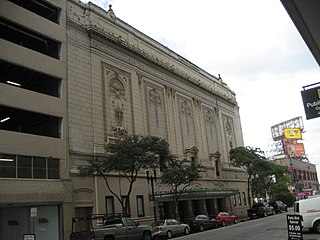
The Orpheum Theater is a theater in the Central Business District of New Orleans, Louisiana.
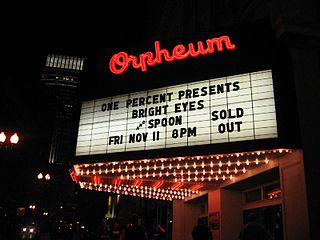
The Orpheum Theater is a theater located in Omaha, Nebraska. The theater hosts programs best served by a more theatrical setting, including the Omaha Performing Arts Broadway Season, presented with Broadway Across America, and Opera Omaha's season. The theatre is listed on the National Register of Historic Places. The main auditorium is a proscenium theater known as "Slosburg Hall". The theater has a theatre organ, made by Wurlitzer.
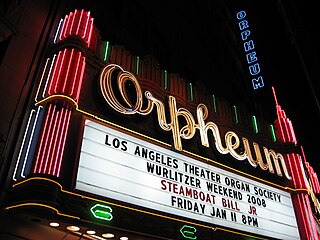
The Orpheum Theatre at 842 S. Broadway in Downtown Los Angeles opened on February 15, 1926, as the fourth and final Los Angeles venue for the Orpheum vaudeville circuit. After a $3 million renovation, started in 1989, it is the most restored of the historical movie palaces in the city. Three previous theatres also bore the name Orpheum before the one at 842 Broadway was the final one with that moniker.

The Orpheum Theatre is a music venue located at 1 Hamilton Place in Boston, Massachusetts. One of the oldest theaters in the United States, it was built in 1852 and was originally known as the Boston Music Hall, the original home of the Boston Symphony Orchestra. The concert hall was converted for use as a vaudeville theater in 1900. It was renamed the Orpheum Theatre in 1906. In 1915, the Orpheum was acquired by Loew's Theatres and substantially rebuilt. It operates as a mixed-use hall, primarily for live music concerts.

The Orpheum Theatre is a historic theater in downtown Wichita, Kansas, United States. It was designed by renowned theatre architect John Eberson with funding from a group of local investors and opened on September 4, 1922.
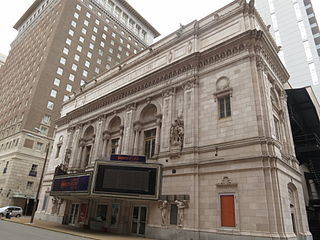
The Orpheum Theater in St. Louis, Missouri is a Beaux-Arts style theater, built in 1917. It was constructed by local self-made millionaire Louis A. Cella and designed by architect Albert Lansburgh. The $500,000 theater opened on Labor Day, 1917, as a vaudeville house. As vaudeville declined, it was sold to Warner Brothers in 1930, and served as a movie theater until it closed in the 1960s.
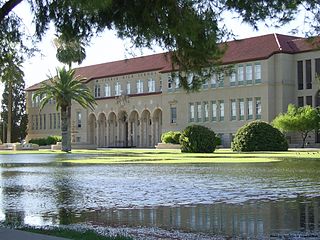
Lescher & Mahoney was an American architectural firm from Phoenix, Arizona.

The Orpheum Circuit was a chain of vaudeville and movie theaters. It was founded in 1886, and operated through 1927 when it was merged into the Keith-Albee-Orpheum corporation, ultimately becoming part of the Radio-Keith-Orpheum (RKO) corporation.
Ashurst Hall is a building on the Northern Arizona University campus in Flagstaff. It was originally built as the 'missing' wing to Old Main and was finished in 1920 but didn't actually connect to Old Main until 1989. Old Main was constructed in 1894 and was initially a reform school for youth. After that, Old Main was going to be a mental institution but was then was established as the Arizona Normal School. Ashurst was the first auditorium on the NAU campus. Ashurst's architecture mirrors Old Main's with window circling the building. Ashurst Auditorium has been used for banquets, dances, and recitals. In April 1930, Lowell Observatory announced it discovery of Pluto in Ashurst. It was named after Henry Fountain Ashurst who introduced the bill for the establishment of the university in 1899. Ashurst Hall has been remodeled twice, once in 1952, and again in 1989. It served an important role in the development of the performing arts in Flagstaff because it was one of the first auditoriums in Flagstaff. Ardrey Hall was built in 1972 meaning that Ashurst predates it by 52 years. Its also predates Prochnow auditorium by 32 years. Before its construction, the school had assemblies and big gathering at the Orpheum Theater down town, afterwards, major gatherings could be held at Ashurst on campus.

Flagstaff is a city in, and the county seat of, Coconino County in northern Arizona, in the southwestern United States. Established as a modern settlement in 1876 and incorporated as a city in 1928, the land had previously been lived on by native peoples of the southwest, primarily the Sinagua. Mountaineer Antoine Leroux then traveled the area, with Edward Fitzgerald Beale following in his footsteps and establishing a trail through the city in the mid-1800s. With a local spring, a small settlement grew by the wagon road, and the town was dominated by the McMillan, Riordan, and Babbitt families. Focused on agricultural pursuits, these families constructed some historic red stone buildings that still stand today.
KUMA was a radio station broadcasting in Yuma, Arizona, United States. It had operated since 1925 as KFXY, based in Flagstaff, becoming KUMA and moving to Yuma in 1932. As a result of an unauthorized transfer of control of the radio station, the Federal Communications Commission ordered its license revoked in 1939 and the station off air as of February 1, 1940.

Downtown Flagstaff, Arizona sits in the western part of the city, and consists of several culturally-connected blocks. The city of Flagstaff has a downtown culture of local, independent, stores inside historic buildings.















